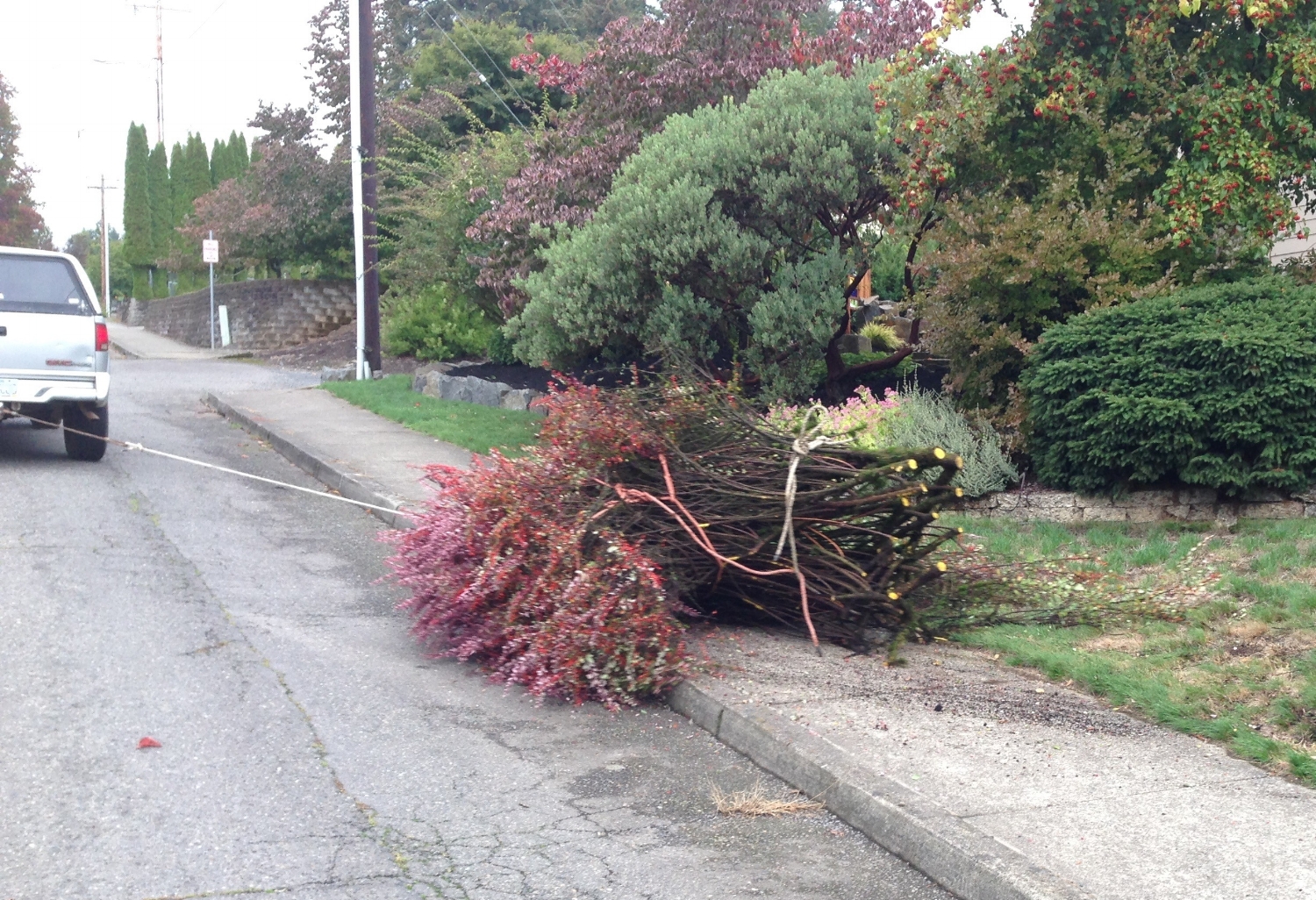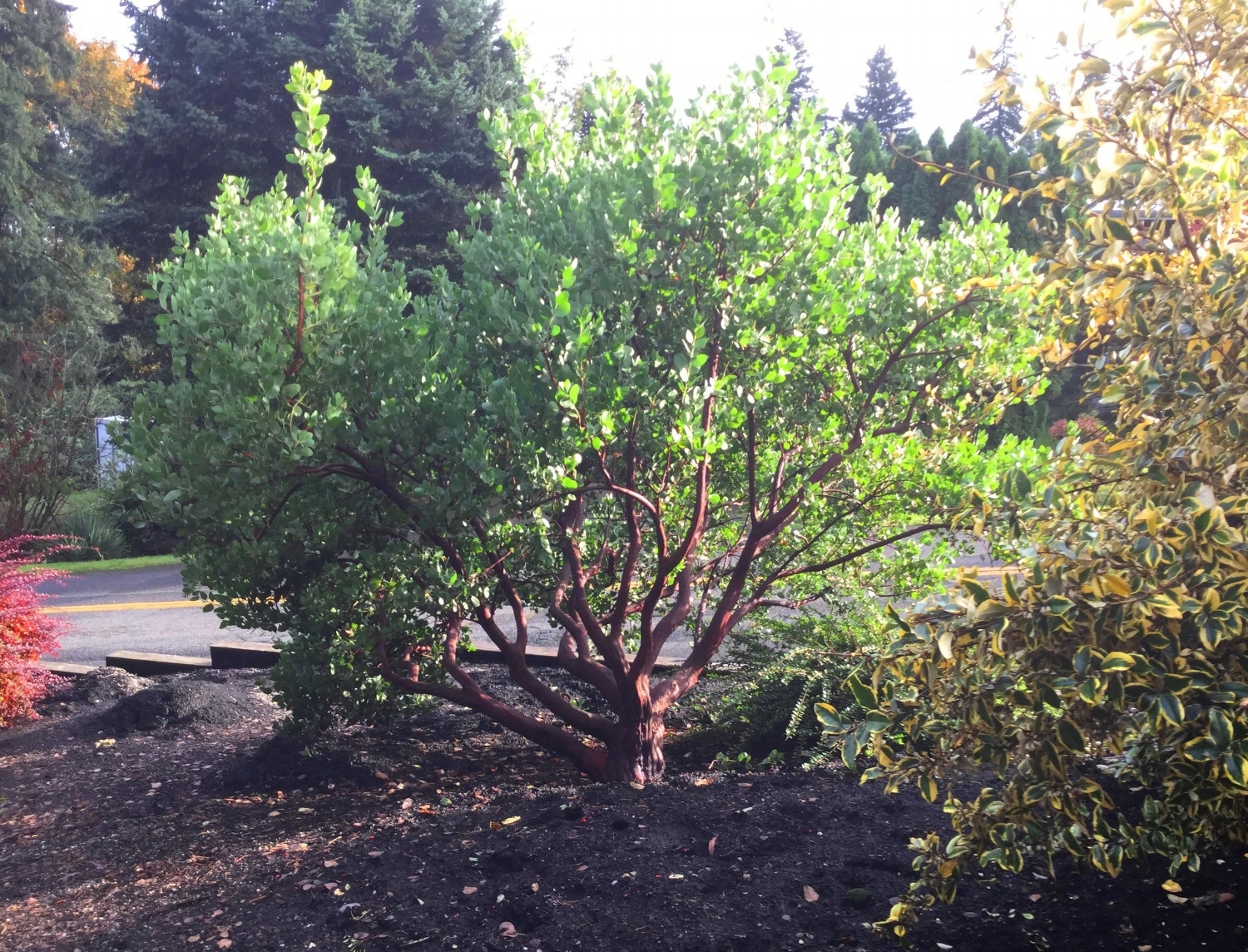Deer fence progress: Barberry removed (SE Quad, part I)
/Berberis thunbergii 'Rose Glow'
Our yard, “southeast quadrant,” part 1 (an introduction)
This is the story of the life of a Rose Glow Barberry, a deer fence, a manzanita, the difficulties of designing one's own space, and the progress of our own yard, fall 2016.
First, some back story:
In our own garden, we've been needing a deer fence for a long time. We also have a piece of yard I'll call the southeast quadrant, which has never been fully usable. It slopes to the south and east, which is a lovely aspect, but also it is open to a very public street, and is serious deer strolling grounds. Deer super highway. Deer heaven. (This, my husband tells me, is because they love me, so much. Umm hmmm.)
Well, when the fence posts from our previous fence finally gave out, it presented an opportunity to redesign a new fence, this time to 1) be full height for deer protection, and 2) to expand the area it covered--into the southeast quadrant. A win on two fronts.
Now to design such a fence. It is proving trickier than first thought.
Difficult fence location decision
They say your own garden is the hardest one to design. This is woefully true. For many reasons--from budget, to attachment, to arguing with your spouse (!), to arguing with your perfectionist self (!!)--many things conspire against the changing and improving of your own living space.
Regarding our southeast quadrant, there are these challenges of site:
slope, cross-slope, public street, looming house almost 3 stories at this sloped off point. It is full sun and difficult to get a hose to, so we've (mostly) chosen not to irrigate. An ancient stand of horsetail rush is another reason not to irrigate, as it does not favor the dryness (although someone forgot to tell that to the horsetail). And of course there's the deer.
Reshaping this space with a fence (a wall right down the middle) has me quite stuck, but I do love a challenge. There's a large expanse the fence must cross; there's proximity to street (height limitations), and existing mature plants in the way. I cannot see all the way to the end of this project; I have just an inkling of a vision.
Whenever you are stuck on designing a new space, it is most freeing to first create a clean slate.
Progress--the barberry removal
Clearing, "editing," pruning, demolition. We started out one day last week, and just kept going.
Our biggest step forward was the decision to remove a big, old, Rose Glow Barberry that had carried this section of the yard for many years. There were many reasons I'd kept it for so long--it's form, its proportion to the overall scheme, its color, its autumn splendor, its fantastic drought tolerance and resistance to deer.
This is a pic from a few years back, with the south sun behind the red fall color of the barberry. In this shot, I had just pruned up the branches off the ground. That helps a barberry look more tidy, and makes horsetail removal easier. But it doesn't last very long (the low branches grow back), and it is a wicked, needle-filled job.
Years ago, I used to have more Barberries, and oh how I was drawn outside with my camera every fall, when autumn splendor hit.
Barberries are truly admirable for their toughness. Useful where you need their indestructible quality; good for hot, sunny, non-irrigated, large spot with zero attention. Just be sure you give them enough room, as their ultimate size can fool you.
This photo of the barberry we finally removed after 20 years last week, is from Spring of 2008. It shows that most of the plant had reverted to straight purple. Note weedy horsetails tangled with the barberry at ground level, and the young Dr Hurd Manzanita in front.
I resisted removing this particular Rose Glow Barberry for so long. But what pushed it over the edge for me that day was, once again, trying to prune it up off the ground (that zone being the most difficult to weed), and improve its looks. I'd done it before, so I should have known, but man! what a tangled, thicket-y, nasty thorny job. Out of all the thorny shrubs I own, the barberries are by far the wickedest.
'Before' picture, Oct 2016 - which is actually a 'During' shot, taken when I had improved some of the lowest branches already. You can see how old and tired the area had become.
Here shows my continued attempt to improve the looks of the barberry. Though still a rat's nest of branches, its fall colors accented the Manzanita trunks beginning to be revealed behind it.
The barberry was right where the fence could go. I actually was trying to locate that fence around it. Until after 3+ hours of attempting progress on its thicket (improving it minimally at best), it "bit" me one last time. It had to go.
Berberis thunbergii 'Rose Glow' bare limb showing needle-like thorns. Fall color and berries remain on branches in background.
Another 'Before/During' shot of the overall area, before removals. Joe is preparing his ropes/chain for pulling out the bush with our truck.
The above is the picture I will save forever to remind me of the surprisingly large scale of Berberis thunbergii 'Rose Glow,' and other barberries ultimately as well. At time of removal, the Rose Glow was 7-8' tall, 10-11' across.
Synching it up.
Wrapping it up into one mass
Chain around crown at base, will be used for removal with truck.
After pulling out with truck.
Crown roots are cut off, to prevent dragging a trail of dirt behind the truck.
Keeping the chain attached, Joe uses truck to pull the bulk of the shrub up to the debris pile, with considerably less effort than otherwise.
Fast forward. After much clean-up and some new mulch down, here is the cleared and cleaned area as seen from above. The largest barberry once stood in the dark-mulch area center right. (One barberry remains, upper right.)
Imagine my great pleasure, when finally looking up from my work, I rounded the bend and this greeted me...
...the Dr Hurd Manzanita that had been fully revealed, after its whole life having been shielded on this side by the barberry.
Arctostaphylos 'Dr Hurd', Oct 2016
8-year-old Arctostaphylos 'Dr Hurd' and 20-year-old Berberis t. 'Rose Glow' in fall.
We had never seen the back side of the Dr Hurd Manzanita, not like this, even though I have been lightly pruning it from its youth, limbing it up to show the beautiful trunks I knew it eventually would have.
One barberry remains, of the original pair planted 20 years ago. This one gets to stay, and I'm glad of it. Further down the hill, its location keeps all the advantages of the barberry and avoids its disadvantages.
What started with the desire to change and improve, gave us this new view. Now to make sure the new fence is a very open grid, to maintain both this view and j-u-s-t enough privacy from the street. The old barberry and the young Manzanita--with textures and warm colors that compliment each other. The old ties in with the new.
Story and photography: Alyse Lansing©, all rights reserved.























